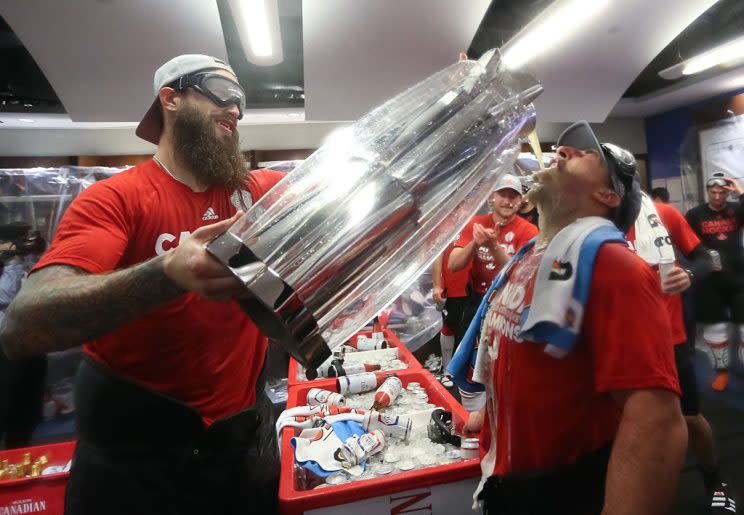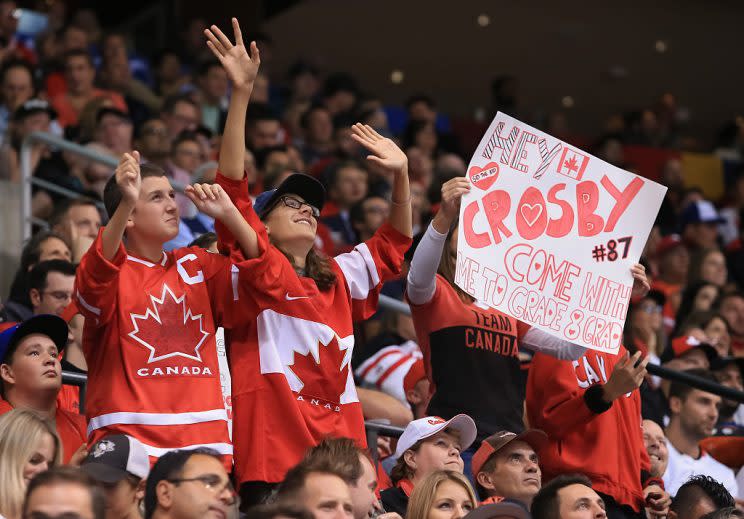Controversial future for the World Cup of Hockey

TORONTO – The NHL is usually pretty adept at giving us too much of a good thing.
Hey, you like hockey jerseys? We’ll have teams wear a different one every few games! Hey, you like outdoor games? Here’s four of them a season! Hey, you like 4-on-4? How about 3-on-3? How about if you like 3-on-3 enough, we make the whole All-Star Game 3-on-3?!
This is what makes the League’s reaction to the World Cup of Hockey so weird. Based on what worked and what didn’t work, you’d expect it would have been ‘Hey, you like Team Europe and Team North America? Here’s both of them, plus Team EuropeBabies, with under-23 European players. Or maybe just European babies. Who can say?!’
Instead, it’s very possible that we’ve seen the last of Team North America and Team Europe. The NHL and the NHLPA have indicated the World Cup of Hockey will likely return in 2020 as a more “traditional” tournament featuring at least eight actual nations and not six countries plus two all-star teams.
“No decision had been made one way or the other. One of the reasons we had the format that we had was not having the ability to do a qualification even to let teams select the last two spots,” said NHL deputy commissioner Bill Daly. “I think the fact that Team Europe succeeded as much as it has and Team North American was successful, one of the objectives we were seeking was creating the most competitive tournament ever. Team Europe being in the final was a validation of the concept. We’ll see where we go with that.”
Donald Fehr of the NHLPA told ESPN.com that they’re going to figure out the future of the World Cup, but echoed the potential to go in a different direction.
“We’re going to look at everything and obviously we’ll talk to the players. We want to look at the reaction in various markets, including the Team Europe markets,” he said. “We want to see if it makes sense to go another route or if it makes sense to continue this or to tweak it somehow. And I don’t want to pre-judge it any of it. One of the benefits we will have by doing that analysis post-facto rather than ahead of time is that we’ll be doing it informed by hard data. And that matters.”
So what can we expect from the next World Cup of Hockey? Some inklings from various conversations, on and off the record, in Toronto:
1 – RIP, Team North America
You were too beautiful to live…
Seriously, without TNA, the preliminary rounds of the World Cup would have been a passionless slog of poorly executed preseason hockey. And that was just Team USA!
We digress. Injecting the under-23 team into the World Cup of Hockey was like blasting Darude’s “Sandstorm” in the middle of a Sam Smith concert. They were fast, creative, playing without the anchors of expectations or repercussions weighing them down. They gave us arguably the best game of the tournament (their loss against Russia) and the most exhilarating moments of the tournament (the first two minutes and last two minutes against Sweden).
And. Those. Jerseys.

Now, logically, this team should exist in perpetuity. But the sense we got is that the NHL wants to shift this whole thing to a more traditional format; that they view this edition of TNA as a once-in-a-generation thing, with Connor McDavid, Jack Eichel, Auston Matthews and the rest (never mind that a 2008 U-23 team would have had Sidney Crosby, Jonathan Toews, Steven Stamkos and Drew Doughty … generations produce generational talent); and that McDavid, Eichel and Matthews should all be available to their national teams in the next tournament.
The common reaction is that it’s a damn shame the U-23 experiment ends after one tournament. Maybe their brilliance, and the fact that we never did get a TNA vs. Canada or USA game, brings them back. But probably not.
2 – RIP Team Europe, Maybe?
If Team North America was the best thing in the World Cup, Team Europe was its greatest story: a collection of NHL stars from “orphaned” countries, coming together and making a run at the championship. They gave Canada its two toughest games. Ralph Krueger probably coached his way back into the NHL in the process.
All indications are that the World Cup will go back to an eight-nation qualifying tournament, which means that the Team Europe gimmick will be dropped. But there’s a part of us that thinks it could survive if the qualification tournament is held to get one team (probably the Swiss) into the pool; so then Team Europe remains the catch-all for other European players. Remember: It’s more important to the NHL strategically to have one guy from France in the World Cup than have a bunch of U-23 players from North America.

3 – The Qualifying Tournament
We’ve danced around this, but here we go: It appears the next World Cup is going to be an eight-nation event with a qualifying tournament leading up to it. Unless they expand it to 12 nations like the Olympics, but that seems unlikely for the second edition after its revival.
Why? Two main reasons. The first is that despite the success of Team Europe, these players would rather represent their own nations. And the rest of the players in the tournament have indicated that they’d rather have a nation vs. nation setup than having two All-Star teams fill out the field, making it feel more like worlds or the Olympics. At least aesthetically.
The other reason the NHL wants a qualifying tournament: You guessed it, MONEY!
In theory, you could have national teams from 16 different nations playing in a qualifying tournament for the World Cup. Which means a multitude of games that can be held around the world. Which means, in theory, a multitude of national team jerseys that Adidas could create and the NHL could sell. Merchandising!
4 – The Money
The NHL has been coy about how profitable this World Cup was. Commissioner Gary Bettman said the profits weren’t “as much as you would speculate or think, because the expenses are extraordinary.” Daly said the tournament was “a relatively minor commercial opportunity.”
“The reason we do this tournament is a much longer vision than a two-week time in Toronto,” said Daly. “It’s laying the foundation for international growth from a commercial standpoint.”
This isn’t just a reference to the potential for a qualification tournament, but to the 2016 World Cup of Hockey as a proof of concept. The ads on the jerseys. The digital ads on the boards from ESPN and Rogers. This was a presentation of the various revenue streams that the World Cup can generate. It’s going to be an easier sell next time.

5 – The Venues
The World Cup of Hockey had 16 games from Sept. 17 to 29 at a single venue: The Air Canada Centre in Toronto. They occurred during successful Blue Jays’ homestands in which the playoff contender drew over 45,000 fans per game. They occurred weeks before a Maple Leafs season where fans had already committed money for tickets. And they occurred before an outdoor hockey game in Toronto in January.
So the buzz for the tournament wasn’t high. Empty seats, although they were sold, were plentiful at games – especially in the afternoon, where a high-profile affair like Sweden vs. Finland was less than two-thirds capacity.
“Even for this market and its hockey passion, it was at times challenging,” said Daly.
The next World Cup of Hockey venue will be up for bid. Expect Edmonton to make a significant one, with a new building and former Hockey Canada boss Bob Nicholson there. Expect Buffalo to make one, with the Pegulas. Expect Russia to make one, and good luck with that.
The intrigue will be whether the NHL splits the venues for the 2020 World Cup.
“I could see splitting games in the future between approximate markets,” said Daly.
Could that mean Toronto and Buffalo? Calgary and Edmonton? Or, in the one that most intrigues us, Philadelphia and New York?
Two venues means no more 3 p.m. starts, which is good for crowds, good for American television but not so good for fans overseas. But two venues also means two locations for the media to cover, and that could end up impacting how the tournament is promoted.
Two venues also means twice the fan bases that will buy gear, and that’s sort of the point.
6 – So, In Conclusion
“The premise behind the way we did this event was we hadn’t done it in over a decade, let’s bring it back, let’s bring it back big and bold,” said Bettman.
That’s why we had Europe and that’s why we had TNA: Because having two all-star teams that featured McDavid, Matthews, Anze Kopitar and Zdeno Chara was bigger and bolder than seeing Slovakia blown out three times.
But now the World Cup is back, and they have at least four years to lay the foundation for the next one. This tournament was an electric shock to the heart of a dead format, and now there’s at least a pulse. They’ll expand it, they’ll better maximize its revenue potential and all we’ll be left with from the 2016 edition are memories of a ragtag group of Europeans playing Canada tougher than the Americans did, and Team North America skating teams into oblivion looking as bad-ass as a team could look.
Unless, of course, the NHL decides these were actually good things, and gives us more of them.
—
Greg Wyshynski is a writer for Yahoo Sports. Contact him at puckdaddyblog@yahoo.com or find him on Twitter. His book, TAKE YOUR EYE OFF THE PUCK, is available on Amazon and wherever books are sold.
MORE FROM YAHOO SPORTS

 Yahoo Sports
Yahoo Sports 

